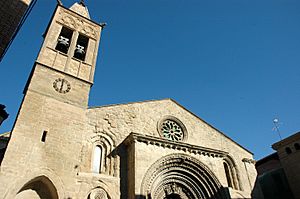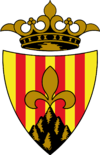Agramunt facts for kids
Quick facts for kids
Agramunt
|
||
|---|---|---|
|
Municipality
|
||
 |
||
|
||
| Country | ||
| Community | ||
| Province | Lleida | |
| Comarca | Urgell | |
| Area | ||
| • Total | 79.6 km2 (30.7 sq mi) | |
| Elevation | 337 m (1,106 ft) | |
| Population
(2018)
|
||
| • Total | 5,393 | |
| • Density | 67.75/km2 (175.47/sq mi) | |
| Demonyms | Agramuntí, agramuntina | |
Agramunt (Catalan pronunciation: [aɣɾaˈmun]) is a municipality (municipi) in the comarca of the Urgell in Catalonia. It is situated in the north of the comarca, near the border with the Noguera. The town centre is protected as a historic-artistic monument, especially the Roman church of Santa Maria which dates from the 12th-13th centuries. The town is also known for the production of torró d'Agramunt, a sort of confectionery traditionally eaten at Christmas. The town is linked to Tàrrega by the C-240 road, to Cervera by the L-303 road and to Artesa de Segre by the L-302 road. The Urgell canal passes through the municipality, crossing the Montclar range through a tunnel. The municipality includes the exclave of Montclar d'Urgell to the north-west.
Historically, a Jewish community existed during medieval times. In 1272, Shlomo ibn Aderet mediated a dispute between the Jewish communities of Agramunt and Lérida. The Jewish community was destroyed in the 1492 expulsion of the Jews. In the 1980s, a street in the historical Jewish quarter, also called a Call (the term is thought to have originated from the word kahal in Hebrew, meaning "community"), was renamed to "carrer del Call," or "Street of the Call."
Demography
| 1900 | 1930 | 1950 | 1970 | 1986 | 2007 |
|---|---|---|---|---|---|
| 3191 | 3290 | 3535 | 4428 | 4618 | 5434 |
See also
 In Spanish: Agramunt para niños
In Spanish: Agramunt para niños



